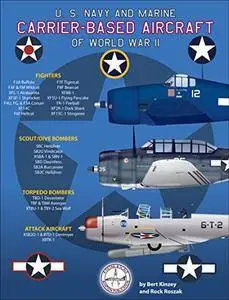U. S. Navy and Marine Carrier-Based Aircraft of World War II by Bert Kinzey
English | 24 Jun. 2018 | ISBN: 1982962127 | 114 Pages | PDF | 242 MB
English | 24 Jun. 2018 | ISBN: 1982962127 | 114 Pages | PDF | 242 MB
The latest book from Detail & Scale is a unique look at all of the American carrier-based fighters, scout/dive bombers, and torpedo bombers of World War II. Each of the well-known aircraft types are covered, but so too are the lesser known aircraft that reached the flying prototype stage during the war. The book also includes a section with maps showing the major battles and engagements as well as the capital ship losses on both sides in the Pacific Theater. The final section covers Navy paint schemes and markings used on these aircraft in the years leading up to the war, and how they continued to evolve during the conflict.
The Navy and Marine fighter chapter covers fourteen aircraft. The most famous of these are the F2A Buffalo, F4F Wildcat, F4U Corsair, and F6F Hellcat. Also included are those aircraft that were flying operationally as the war came to an end, such as the F7F Tigercat, F8F Bearcat, and the FR-1 Fireball, although none of these arrived in theater in time to see combat. Finally, this chapter covers those aircraft that were not pursued for a variety of reasons after the prototype flew. These aircraft either carried exotic names like Airabonita, Skyrocket, Flying Pancake, Dark Shark, and Stingeree, or they were never given a name, simply being known by their designation like the Curtiss XF14C and XF15C-1, and the Boeing XF8B-1.
The next chapter covers eleven torpedo bombers, scout/dive bombers, and the beginning of a new generation of attack aircraft. Again, the well-known types, including the two Curtiss aircraft named Helldiver, the Devastator, Vindicator, Dauntless, and Avenger, are covered. Other named aircraft in the chapter are the Buccaneer, Sea Wolf, and the Destroyer, while the designation-only aircraft include the Brewster XSBA-1 and SBN-1, and the Kaiser-Fleetwings XBTK-1.
Each aircraft section includes photographs and a history of the aircraft. For those with significant histories, each variant of the aircraft is described and illustrated. Photographs of cockpit and aircraft details, long the trademark of Detail & Scale publishing, are also included for the most famous variants.
The book also includes two appendices. The first provides maps and a brief history of naval combat in the Pacific Theater in World War II. The second contains a significant amount of colorful details on the paint schemes used on Navy and Marine aircraft, and the general marking systems in use. This look begins with the colorful “Yellow Wing” aircraft of the 1930s and shows how war clouds on the horizon in 1940 began a six-year period of evolving camouflage schemes for naval combat aircraft. Details of Navy markings over the same timespan are also provided and are profusely illustrated with artwork.
U. S. Navy and Marine Carrier-Based Aircraft of World War II is a unique look at a fascinating period of American naval aviation history. The book features 271 pages, with over 280 photographs (more than 60 in color) and 31 full color aircraft profiles and over 60 markings illustrations.



